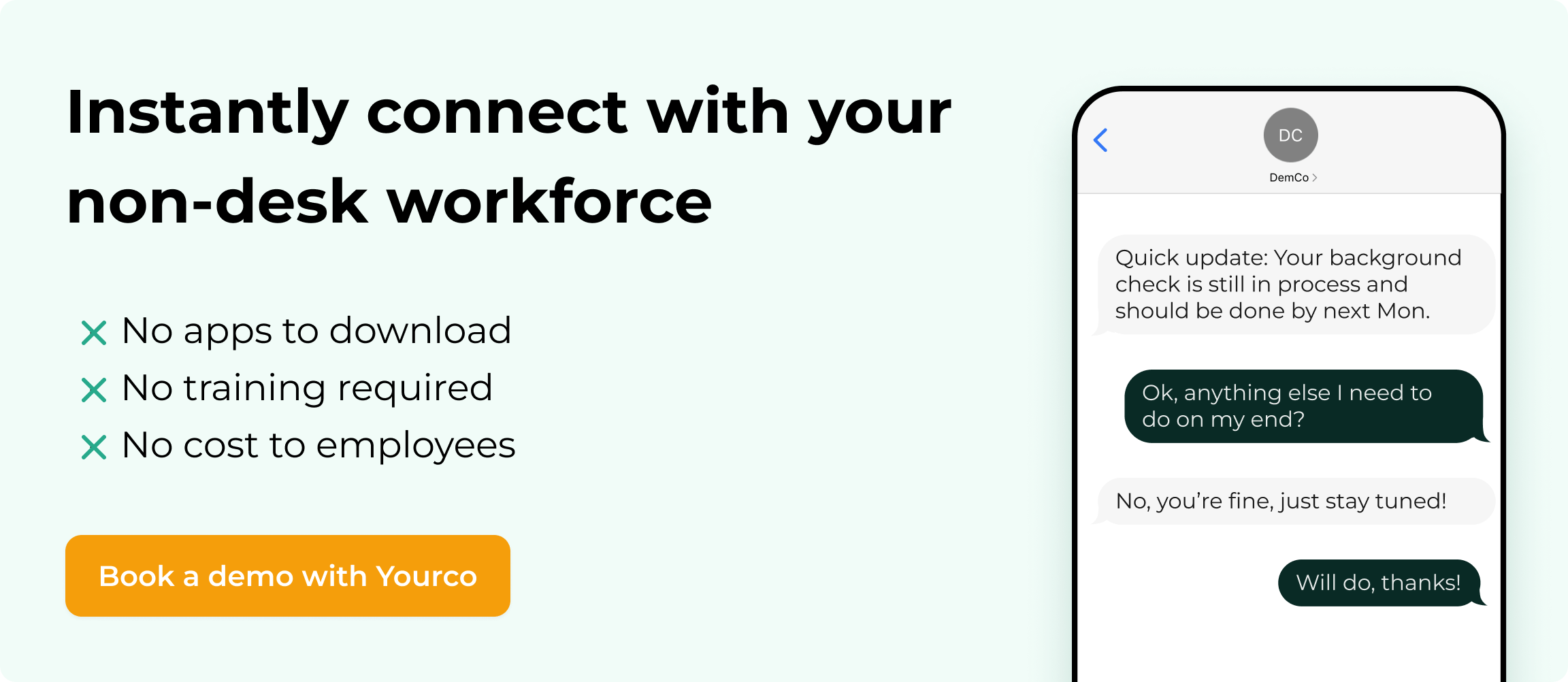Demand-Based Scheduling: A Guide to Smarter Staffing


You know the headache: one week you're trying to find extra hands for a Saturday rush, the next you're paying wages to employees who spend whole shifts waiting for customers to appear. Traditional "set-and-forget" schedules swing between overstaffing and understaffing, wasting money and wearing down morale. Demand-based scheduling fixes that by using real data to predict when work will spike and line up the right people at the right time.
In this guide, you'll see what demand-based scheduling is, how it works, why traditional models fall short, and which tools turn raw data into reliable forecasts. We'll dive into industry-specific use cases, step-by-step implementation tips, and strategies to keep both managers and frontline teams happy. By the end, you'll have a clear roadmap for replacing guesswork with science and reclaiming control of your labor budget.
What Is Demand-Based Scheduling?
Demand-based scheduling is straightforward: you use real numbers to put the right people in place at the right time. Instead of guessing when you'll need staff, you look at sales data, customer traffic, order volumes, and even weather patterns to build every shift around clear evidence of when work will actually happen.
This approach keeps your team size matched to your business activity. You can analyze past events to identify patterns, then use current information to detect sudden changes before they become problems. This helps you add or reduce staff before rushing to address understaffing or overstaffing.
The system adapts as things change. When an unexpected rush hits, such as a surprise lunch crowd or a surge of online orders, your schedule adjusts automatically. You cover the demand without blowing your budget. The same system also keeps you compliant with overtime rules, break requirements, and each worker's availability, so you stay within labor laws while respecting what your team needs.
Everything runs on information you already have. Based on the past busy periods, you can:
- Determine when crowds typically show up
- Pull data from point-of-sale system or inventory scanners to see what's happening right now
- Use that information to predict what tomorrow will bring
With this foundation, your staffing plans stop being reactive and start working like a reliable forecast. Here’s how that looks in practice:
- Retail teams use sales data to prepare for holiday rushes
- Hospitals track patient numbers to add nurses during flu season
- Logistics centers match their workforce to shipping volumes
Wherever demand changes, a fact-based schedule helps you serve customers better, keep employees satisfied, and control costs without the stress of constant guesswork.
How Demand-Based Scheduling Works
Demand-based scheduling uses real business data to build smarter, more accurate staffing plans. Instead of reacting after problems arise, you shape each shift based on what’s actually happening, both historically and in real time. Here’s how that works:
Gathering the Right Data
Demand-based scheduling starts by collecting the information you already have. That includes:
- Past sales records
- Customer traffic patterns
- Inventory activity
- Seasonal trends
- Local events and weather forecasts
Modern scheduling tools pull this data directly from your systems, such as your POS, traffic counters, or inventory scanners, so the feed stays up to date without requiring extra effort.
Forecasting Demand
The system analyzes historical patterns and current signals to predict how busy you’ll be by hour, day, or location. These forecasts account for:
- Regular demand cycles (like weekend foot traffic)
- Short-term spikes (like sales promotions or storms)
- External factors (like holidays or public events)
The result is a reliable picture of tomorrow’s workload, tailored to your business.
Translating Forecasts Into Staffing Needs
Forecasts are only useful if they lead to action. Here’s where the system turns projected demand into exact staffing requirements. For example:
- A spike at 3 p.m. might translate into two cashiers, one stocker, and a shift supervisor.
- Labor rules and wage limits are automatically checked during this process.
This helps you stay compliant with legal and operational constraints, without manual review.
Building Schedules That Match
Next, the platform matches staffing needs with employee availability, skills, and preferences. It considers:
- Time-off requests
- Required certifications
- Hour limits or overtime rules
Instead of piecing together a schedule by hand, managers see optimized options that reduce costs without cutting corners on service or compliance.
Adjusting in Real Time
If conditions change, say, a sudden rush or weather delay, the schedule can adapt instantly. The system updates its forecast and suggests:
- Shift swaps
- Overtime
- Alternate coverage options
This flexibility helps teams avoid last-minute chaos.
Keeping Everyone in the Loop
Schedules are only useful if people can access them. Demand-based systems deliver updates in whatever format your team prefers:
- Mobile apps
- Text messages
- Printed schedules
That makes it easy to reach deskless workers who don’t check email or use company apps regularly.
Technology and Tools That Enable Demand-Based Scheduling
The right technology turns workforce forecasting from theory into daily practice. You need systems that collect clean data, translate it into accurate predictions, and deliver clear shift information to every worker, whether they manage from an office or scan products on the warehouse floor.
Workforce Management (WFM) platforms serve as your scheduling command center. They collect sales, production, or patient-census figures and automatically build rosters that match demand hour by hour. When these systems replace spreadsheet scheduling, organizations typically cut operational costs through fewer overstaffed periods and reduced overtime.
Accurate schedules depend on forecasting engines powered by advanced analytics and AI. Machine-learning models study historical patterns, such as holiday rushes, weather impacts, and flash sales, and predict exactly when you'll need an extra picker on the loading dock or another nurse on the night shift. These forecasts refresh continuously, feeding real-time adjustments back to your WFM system when demand shifts unexpectedly.
Cloud-based scheduling tools make your schedules accessible everywhere. Managers can approve shift swaps from any location, and corporate teams can compare coverage across sites without hunting through email attachments. Integration connectors keep data flowing between point-of-sale, HR, and payroll systems, eliminating manual data entry and the errors that follow.
Reaching Every Worker Every Shift
Employee communication determines whether your scheduling system succeeds or fails. Most frontline workers don't regularly use workplace apps or have reliable Wi-Fi access, so SMS notifications reach them where they already pay attention. A text reading "Your Thursday shift moved to 10 a.m." gets understood instantly, requires no training, and prevents missed shifts. Some organizations supplement SMS with dedicated employee communication apps for office-based staff, but SMS remains the universal way to keep everyone informed.
Before selecting tools, map your specific requirements. High-volume retailers need deep point-of-sale integration, while construction firms might prioritize GPS-verified clock-ins. Evaluate each vendor's integration capabilities, user interface, and reporting features.
Start with a pilot program using one crew, gather feedback, and refine your setup before expanding company-wide. When your technology fits your operation and speaks your employees' language, intelligent scheduling delivers its full potential.
How to Implement Demand-Based Scheduling in Your Organization
Matching staffing to real demand takes planning, data, and the right approach. These ten steps will move you from guesswork to a reliable, data-driven schedule that cuts wasted wages and keeps your team happier.
1. Audit Your Current Scheduling Process
Start by mapping how schedules get built today. Ask yourself these questions:
- Where do delays, last-minute inconveniences, or overtime spikes happen?
- How often do you find yourself overstaffed during slow periods or short-handed at peak times?
Document these pain points so you can measure improvement later.
2. Establish Clear Goals and KPIs
With gaps identified, set concrete targets. Focus on:
- Staffing costs as a percentage of revenue
- Customer wait times or service levels
- Employee satisfaction scores
- Overtime hours per week
Define success in numbers so every stakeholder can track progress. These KPIs will guide tool selection and model tuning in later steps.
3. Gather and Analyze Historical Demand Data
Collect at least one year of data (three years is even better) to capture seasonality. Pull sales or transaction details from point-of-sale systems, production volumes from ERP software, appointment logs, web traffic, and even weather or event calendars that influence demand. Mine this information for hourly, daily, and weekly patterns.
4. Select Scheduling Tools That Fit Your Operation
Look for workforce-management software or forecasting tools that can import your historical data with minimal cleanup, apply predictive analytics to create demand curves, enforce regulatory compliance automatically, and communicate schedules through channels every employee can access.
For many frontline teams, SMS proves more reliable than apps or email since it works on any phone. Avoid feature bloat and choose the platform your managers will actually use daily.
5. Create a Data Integration Plan
Your new tool only works as well as the data flowing into it. Work with IT to connect POS feeds, HR systems, payroll, and any external data such as weather APIs. Aim for automated, hourly updates so forecasts stay fresh.
6. Develop Scheduling Rules That Balance Efficiency and Fairness
Translate your KPIs into system rules. Set:
- Maximum hours per employee per week
- Minimum rest periods between shifts
- Certified skills required on each shift
- Employee preference weighting for start times or days off
Embedding these rules up front prevents any scheduling conflicts before shifts get published, ensuring the algorithm produces schedules that respect both compliance and morale.
7. Pilot in One Department or Location
Choose a unit with manageable complexity — large enough to show impact, small enough to limit risk. Run the pilot for at least one full demand cycle. For retail, that might mean a weekday and a weekend; for manufacturing, a full production run.
Compare pilot KPIs against your baseline. Success builds confidence and uncovers tweaks before a wider launch.
8. Train Managers and Employees
Data-driven scheduling changes workflows, so clear training matters. Show managers how to read demand forecasts and approve real-time adjustments. Teach employees how to view schedules, offer availability, or claim open shifts. Better transparency around shift assignment drives engagement and reduces turnover.
9. Collect Feedback and Iterate
After a few weeks, survey managers and frontline staff. Are forecasts matching reality? Do employees feel schedules are fair? Use both feedback and KPIs to fine-tune forecasting parameters, staffing thresholds, and communication timing.
10. Expand Across the Organization
When the pilot consistently meets or beats targets, roll out to additional departments, locations, or regions. Repeat the data-integration and training playbook each time, and keep refining models as more data accumulates. At scale, the compounded gains, such as reduced operational costs, faster customer service, and steadier paychecks, reinforce the value of the entire program.
By following these steps, you'll replace guesswork with data and build a scheduling process that flexes gracefully with real-world demand.
Rethink Scheduling for a Smarter, Stronger Workforce
Intelligent workforce planning puts the right people in the right place at the right time — no guesswork, no wasted hours. When schedules follow real demand, organizations typically cut staffing expenses and keep service quality strong.
Beyond reduced wage costs, you'll see the difference on your floor. Fewer moments of rushing to cover gaps, happier employees whose availability gets respected, and customers who receive quick, attentive help instead of waiting around. This shift moves you from rigid templates to flexible schedules that adapt to each shift's unique needs.
Take a close look at your current setup. Do you have hours where team members stand around with nothing to do, or rush to cover sudden gaps? If this sounds familiar, a smarter approach is within reach, and it doesn't require every worker to master new technology.
Yourco makes predictive scheduling work for non-desk teams through simple SMS. You publish shifts, employees confirm or request swaps, and everyone gets updates instantly on the device they already check throughout the day. No apps to download, no complex systems to learn.
Ready to see how this works in your operation? Try Yourco for free today or schedule a demo to start building schedules that match your reality, rather than outdated traditions.
FAQs
How Difficult Is It To Connect A New WFM Platform To Our Existing Payroll System?
Most leading platforms offer pre-built connectors or open APIs that handle standard integrations. A brief discovery call with your IT team can identify specific data requirements and prevent downstream complications. The initial setup typically takes a few weeks, but saves countless hours of manual work afterward.
Do We Need AI Forecasting Capabilities From Day One?
No. Start with rule-based forecasting using your historical data, then add machine learning features as your data collection improves. Clean, consistent data input matters more than sophisticated algorithms. Many organizations see immediate benefits from basic demand patterns before advancing to AI-powered predictions.
Will SMS Schedule Updates Create Extra Costs For Employees?
Standard text messaging rates apply, but most workers already have unlimited texting plans. Because SMS doesn't require app downloads or data usage, it remains the most inclusive way to reach all employees with schedule information. The communication reliability typically outweighs any minimal costs, and many organizations find SMS reduces costly no-shows and scheduling confusion.
How Quickly Can I Switch To Data-Driven Scheduling?
Most teams can pilot the approach at a single location within a few weeks, then expand once the benefits become clear.
Will Employees Lose Control Over Their Hours?
Not at all. Yourco collects availability and preferences first, then matches them to forecasted demand.
Do I Need New Hardware?
None whatsoever. If your team can receive text messages, you're ready to go.
How Much Historical Data Do I Really Need Before I Start Forecasting?
A full year captures seasonality, but three years delivers stronger trend lines. If you're launching a new site without history, start collecting data immediately and use industry benchmarks to guide initial schedules.
What If Employees Push Back Against Variable Schedules?
Bring them into the process early. Explain how predictive scheduling can provide more predictable hours and reduce last-minute changes. Offering preference input and transparent rules helps build trust.
Can Small Businesses Afford The Technology Required?
Yes. Many workforce-management platforms offer tiered pricing, and even basic tools can import sales data, model demand, and send SMS schedules without the enterprise price tag.



